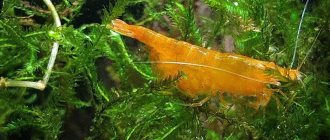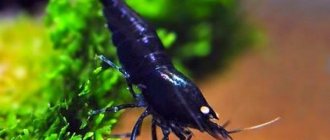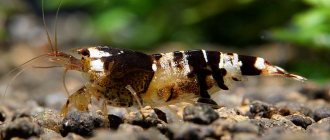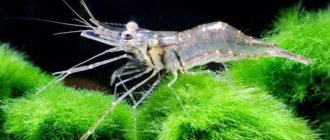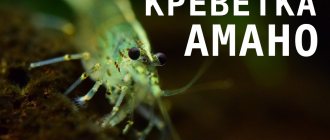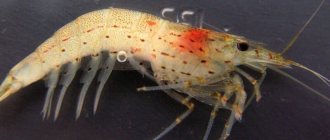Shrimp are the most highly organized crustaceans of their class. Today they can be found not only in natural conditions - seas and oceans, rivers and lakes.
Often people place them with other aquarium inhabitants. Decapod crustaceans serve both as an aquarium style, a way to diversify and maintain biobalance, and as an excellent cleaner.
There are a large number of species of freshwater aquarium shrimp: Blue Dream, Riley, Black Tiger, Cardinal, Cherry, Macrobrachium and many others. All of them are interesting and unique in their own way. Shrimp Filter occupies an equally worthy place among them.
English name is Bamboo Shrimp, scientific name is Atyuopsys moluccensis. Other names: “Asian shrimp” (due to its habitat), Bamboo shrimp, etc.
General information about filter feeder shrimp
The filter feeder shrimp (Atyopsis moluccensis) is a large freshwater shrimp that is also sold under other names: bamboo shrimp, banana shrimp, forest shrimp, fan shrimp, Singapore shrimp and atyopsis. One of the main features of this shrimp is its amazing way of capturing food, which we have already mentioned. The first two pairs of legs of a shrimp are like a fan with a large number of small spines that grab and hold prey, as if filtering it from the water. Under natural conditions, the filter feeder shrimp feeds on microorganisms and small pieces of food.
Each fan bristle is equipped with a receptor that informs the shrimp whether the catch is edible.
Note ! The crustaceans described in the article are compatible with most tropical fish. These are the largest aquarium shrimp, the body size of adults reaches 10 cm. Moreover, females are larger than males.
About twice a month, adult filter feeders molt, and their relatives happily eat the shed shell. The “crustaceans” themselves are easy-going, but shy, defenseless and love to hide in shelters. They should not be kept together with large predatory fish.
Filter feeders feed using special bristles on their forelimbs
Habits of Athyopsis
These creatures swim quite well forward and backward. Most often they move head forward, but if there is danger they quickly back away.
These guys can often be seen on aquarium pumps and filters.
They are not bottom-dwelling creatures. Atiopsis move throughout the entire space of the aquarium: the bottom, surface of the water, decorative snags and aquarium equipment. The main condition is the presence of a strong current. After the water source weakens, they go in search of a new “turbulent” place. It can be installed independently near the filter exhaust. Make ridges on the glass using sticks and suction cups.
Young individuals prefer to hunt secretly. They hide under snags and leaves. The shrimp remain in this position for several weeks. With age, they become bolder and increasingly swim to the surface.
Appearance
Filter-feeding shrimp have an elongated, banana-shaped body. Such a massive body (on average, 6-10 cm) is necessary to stay in the current; special hooks located on the front pair of walking legs are intended for the same purpose. In search of food, shrimp select a suitable place and wait for the food to swim to them and become entangled in the “nets.”
Catching limbs of filter feeder shrimp
The modified limbs mentioned above are used to catch prey . They are two hemispheres with a row of dense bristles. Pieces of food and microorganisms get stuck between the villi, and the shrimp confidently puts them into the mouth. What is characteristic is that the limbs work alternately: while one catches food, the second sends it into the mouth.
As for the color of filter feeding shrimp, it can be different - yellow, green, brown, sand, etc., but almost always it looks colorful and motley. The specific color depends on many factors, including:
- place of catch;
- feeding features;
- general color scheme of the aquarium.
The color of filter feeder shrimp can be very diverse
Note ! It is difficult to predict what color a shrimp will be after being placed in an aquarium. We also note that there is a pale yellow or white stripe running along the top of the shell.
The average lifespan in an aquarium is 1-2 years, and even more under favorable conditions.
There is an opinion among aquarists that the bright color of a shrimp's shell indicates good health. But as a result of long-term observations by aquarists, something else became clear: throughout life, the color varies depending on nutrition and environmental conditions. Moreover, even the color of the soil matters, because the color of the filter feeder shrimp also plays a protective role. Although after the end of molting, the shells of all shrimp are translucent with a barely noticeable light orange or white tint.
Often, even the color of the soil is important, since in the wild, color also plays a protective role for this animal.
Sexual characteristics . Male filter feeders are distinguished by a slightly elongated first pair of legs, and females by a slightly thickened abdomen (in the latter, mature individuals carry fertilized eggs).
Diseases and prevention
How long filter feeders live depends on nutrition and care, but usually 2 years. These crustaceans have strong immunity, and diseases are usually associated with starvation and poor-quality water.
Common causes of death are increased levels of nitrates and phosphates, low pH, and decreased oxygen. Due to poor quality water, shrimp die in 3-4 days, but dying from hunger can last a long time. The main sign of starvation is prolonged movement along the bottom in search of food.
Prevention - regular feeding of shrimp and maintaining clean water. For the full development of the chitinous shell, it is recommended to periodically pour chalk into the water.
Habitat in nature
The natural habitat of filter feeder shrimp is Southeast Asia. They live mainly in small streams and rivers, because to survive they require a current - all life processes depend on this. First of all, this is the nutrition . Current is also important for the successful reproduction of shrimp: they reproduce in fresh water, but the larvae are carried to salty sea waters, where they turn into adults and return back “home.” This is why it is quite difficult to breed filter feeders at home, and wild specimens are often sold in stores.
In scientific circles this shrimp is called Atyopsis moluccensis
Although today, thanks to modern technologies, you can easily get sea water at home. Therefore, you can safely try breeding filter-feeding shrimp.
Peculiarities of reproduction of aquarium crustaceans
How do shrimp reproduce? Up to two weeks pass between mating and egg laying. Until the babies hatch, the eggs hang on the female's pleopods. During such a crucial period as reproduction, shrimp need peace and safety. Therefore, it is better to place them in a separate container, since in a common aquarium the young animals will simply be eaten by their neighboring fish.
Quite simple living conditions, unpretentiousness, relatively low cost and unusual beauty make these small crustaceans a favorite of aquarists. Observing the life of these exotic aquatic inhabitants can bring peace and harmony to a busy life. Maybe this is what attracts their owners to shrimp?
Post Views: 5,537
Why are shrimp called filter feeders?
If you think that these crustaceans can serve as an aquarium filter, then we hasten to upset you: this is not true. The term “filter” refers to features of the anatomical structure; it defines the method of obtaining food by filtering water.
Filters catch food
This transformation of the limbs into small “fans” allowed the shrimp not to bother searching for prey: they just need to wait for the current to bring food itself. But this feature is also fraught with a certain danger - if a shrimp ends up in a body of water in which there is a lot of suitable food, but there is no active current, it is guaranteed to die of starvation. Because it will not be able to pick up food from the bottom or extract it from the water.
Features of body structure
In the literature, filter-feeding shrimp often has another name – fan shrimp. This is due to the fact that the front pair of its limbs has been transformed into something similar to a fan or panicles, with their help this creature feeds. In crayfish, for example, the forelimbs are modified into claws, and in the banana shrimp, the fourth and fifth thoracic segments are pubescent. Each fan consists of hemispheres formed by dense rows of bristles. It should be noted that this is not the simplest claw structure, but it is so convenient that the food simply floats into the hands. The only thing that is required of the shrimp is to choose a more comfortable place - so that there is a good current.
There are a lot of suspended particles in water that settle somewhere over time. However, how to collect such food? The claws are very inconvenient in this case. But the limbs modified into fans are very good. It should be noted that the filter-feeding shrimp can wield them with great dexterity and incredible speed.
If the water streams carry a sufficient amount of food, then the small creatures do not need to strain at all. The food itself falls into the traps. This is why shrimp in aquariums and ponds position themselves against the current and open their limbs. The fans gradually fill themselves with food. Periodically they slam shut, which indicates that food is getting into the shrimp’s mouth. Moreover, this mechanism is so clearly worked out that while food from one fan enters the mouth, the other is open at the same time and continues to catch. The principle of queue works so as not to waste time.
The filter feeder shrimp is a clumsy creature. Fans are very convenient for feeding, but create significant resistance when moving. Therefore, in order to constantly resist the flow of water, you need to have sufficient body weight for this. In addition, they have another pair of limbs turned into powerful “clingers”. With their help, shrimp are held on to algae and snags, and at the same time they are not carried away by strong currents of water.
As a result, they only have two pairs of legs left to walk. This is completely inconvenient given the body size that shrimp have. That's why they are so clumsy. However, this does not bother the creatures themselves at all; they have adapted perfectly to life.
Kinds
Gabonese filter feeder shrimp (Atya gabonensis) . This is another type of filter feeder that is common among aquarists. It lives in the rocky rivers of West Africa that flow into the Atlantic Ocean.
Gaboon filter feeder shrimp
The body size reaches 15 cm. The color is very attractive: often blue, but can also be beige and pink. It feeds in the same way as a banana shrimp - due to its splayed fan legs. Lives in slightly acidic and warm water with any level of acidity. It feeds mainly on detritus, small algae, microorganisms and crushed dry food.
Behavior in the aquarium
This moment may disappoint you the most - you have never met a more boring creature! The shrimp will not walk around the tank while there is current. Perhaps even the cherry shrimp and ampularia are more active and aggressive than the filter feeder. For example, a cherry tree can learn to gather food on an Athyopsis if you feed it separately.
Banana shrimp in an aquarium
On a note ! For this reason, any peace-loving aquabionts can be kept with a filter - from the same cherry shrimp to newly born guppies. But it is not advisable to keep it with predatory fish (for example, African or American cichlids).
Video – Moluccan filter shrimp
What to feed
It often happens that crustaceans do not receive enough food in pet stores. For this reason, for the first time after settling in the container, they need plentiful feeding.
You can give daphnia, microplankton, frozen food. For normal molting, it is necessary to give food containing chitin: bloodworms, brine shrimp, cyclops (2 times a week).
Remains of plants, algae, and even discarded shells can also serve as delicacies. You can supplement the food with crushed flakes with spirulina (pre-soak the flakes to make a homogeneous paste). In addition, the Filter Shrimp will not refuse carrots, zucchini or pumpkin, which must first be scalded with boiling water for 5 minutes.
Young nettle leaves (but only the upper, tender ones) can serve as a food additive. To do this, they need to be poured with boiling water for 15 minutes to soften.
This type of crustacean usually sits in places where the most intense flow from the filter passes. With their fan-shaped claws, they filter the flow of water, while capturing food. These crustaceans should be fed once a day or every other day. It is advisable to arrange fasting days once a week so as not to overfeed.
How to keep filter feeding shrimp?
The main condition for organizing an aquarium is the heights on which the shrimp will sit and a continuous flow of water. The crustaceans spend all their time on this activity. The aquarium should also be equipped with both an external and internal filter to recreate the water flow. Additionally, you can install a pump that would continuously pump water. Place plants, stones and driftwood in the direction of the flow.
Shrimp filter feeder in the process of obtaining food
Filter-feeding shrimp examine the entire space of the aquarium - not only at the bottom, but also on the equipment, if it rises above the water. By the way, if you do not provide the shrimp with a sufficient number of snags and stones, it will try to position itself closer to the filter, crawl into its tube, and even crawl out of the tank altogether.
Note ! Don't forget to close the shrimp aquarium. If they sit near the water or closer to the surface, it means they do not have enough food.
Provide the shrimp with plenty of hiding places.
Behavior and Compatibility
You should not expect interesting behavior from the filter. The crustacean spends most of its time in a motionless state, with its fan-shaped limbs spread out. Occasionally changes position, moves to another place. If the shrimp begins to move actively, it means there is not enough flow power in the aquarium.
If the reservoir is small, filter feeders may become territorial. But the crustaceans are not pugnacious, they simply push each other, trying to take a convenient place to catch food.
The calm and phlegmatic filter feeder shrimp is highly compatible with all non-aggressive species. It gets along well with small crustaceans: neocardines, Amano. You should not house filter feeders with large crustaceans, macrobrachiums, or crystal shrimps. Among the fish, cichlids, large barbs, and all predatory and aggressive species will be bad neighbors.
High compatibility of the filter with:
- Sword bearers;
- Neons;
- Corridors;
- Guppy;
- Rasborami;
- Tetras;
- Pecilia.
Requirements for an aquarium
Due to the fact that filter feeder shrimp are quite large, they need an aquarium with a volume of at least 60 liters (for a small group). Place any neutral aquarium soil on the bottom.
To decorate the aquarium, use not only stones and driftwood, but also large plants. By placing them in line with the filter outlet, you can watch the shrimp line up and catch food as it flies by. Also very funny are the fights between individuals for the best places.
The soil in the aquarium should be neutral
Filter feeders love live plants; broad-leaved species (cryptocorynes, echinodorus, anubias) are an excellent option.
Optimal water parameters:
- temperature – 22-28°C;
- acidity pH – 6.0-7.5;
- hardness GH – 4-8.
Important ! Shrimp are very sensitive to nitrogen compounds in water, and therefore need to be regularly changed up to 20% of the total volume. They should not be planted in fresh aquariums, since crustaceans love stable water parameters.
Filters in the aquarium
Table of basic parameters of maintenance, care and nutrition:
| What should be the volume of the aquarium? | from 40-60 liters |
| What should the temperature be? | from +23-29 °C |
| What should the pH be? | from 6.5-7.5 |
| What should be the stiffness? | from 4-8° dkH |
| What should be the substrate for an aquarium? | thin grains of the substrate (soil) ranging in size from 3-4 mm |
| What kind of lighting should there be? | moderate |
| What should be the movement of water | moderate |
| Aquarium Shrimp Size | from 6-10 cm |
| What does aquarium shrimp eat? | bloodworm, brine shrimp, cyclops, daphnia, microplankton |
| Who is compatible with in an aquarium? | get along with small non-aggressive fish species |
Feeding
Aquarium water is poor in plankton, and therefore shrimp need to be fed. You can spray any dry food or mixtures, as well as small frozen bloodworms, onto the current. “Live dust” is also perfect.
Frozen bloodworm
It is very important that the water contains some amount of suspended matter. No, the water should not be cloudy, but if it is crystal clear, the filter will inevitably begin to starve.
Breeding and reproduction
As we have already found out, breeding filter feeders at home is very problematic. Indeed, in nature, larvae hatching from eggs are carried away by the current to river beds, where fresh water mixes with sea water. Here the larva develops and turns into an adult shrimp, after which it returns back to fresh water, obeying its instincts.
When the body size reaches 3-4 cm, puberty occurs. For about a month, eggs develop in the female’s tail legs, and then, when incubation is completed, small larvae (no more than 1 mm in size) are born. At the same time, the larvae need salty water, and adults cannot tolerate high salinity. How to be? The only sure way to breed banana shrimp is to catch the newly hatched larvae and place them in a saltwater aquarium. But due to the tiny size of newborns, this task is almost impossible. Not to mention that it is extremely difficult to select suitable food for such small larvae.
Adults cannot tolerate salt water
That is why most of the filter feeder shrimp are wild ones that were caught in open waters.
Maintenance and care
The Filter Shrimp is an unusual and even exotic animal. Therefore, when planning to have it in your aquarium, you need to take into account a number of requirements:
- Aquarium volume. Must be at least 40-60 liters;
- Equipment:
- filter - not only cleans, but also provides the necessary flow of water;
- air compressor - needed for gas exchange (the water in the container does not stagnate). This equipment also serves for other purposes: for the formation of the necessary microflora; if the health status of one of the animals is unsatisfactory; and if there are few plants and many inhabitants in the aquarium, then a compressor is installed on the outside;
- water heater and thermometer. The optimal temperature for keeping is from +23-29° C. If the temperature is too high or too low, it threatens death. Even if the container is located in a fairly warm room, a water heater is necessary to maintain a stable temperature;
- aquarium plants, driftwood, caves, stones. For crustaceans, the presence of living plants is very important - for them it is also food. During the molting period (which does not always occur regularly - every 1-2 months), the Filter shrimp looks for a shelter where it can hide. To do this, in addition to plants, she needs: stones, driftwood, caves.
3. Soil. Should be suitable for both crustaceans and aquarium plants. You can also use neutral gravel without sharp corners (the optimal size of soil particles should be 2-5 mm) or sand (at least 1 mm).
Along with arranging the aquarium, you should also remember about other care rules:
- Every 2-4 weeks, conduct water tests (can be purchased at any pet store): pH value or acidity level. The norm is from 6.5-7.5 pH; hardness from 4-8° dH.
- Every week it is necessary to do a water change - 10-20% of the total water volume (there is no need to move the individuals to another aquarium);
- Approximately once every two weeks, clean the soil using an aquarium siphon (after each feeding, food debris and waste accumulate at the bottom, which begin to rot if not cleaned in a timely manner);
- The water is suitable: ordinary tap water, but previously purified from chlorine with a special conditioner or settled water.
Molting of filter feeders
Shrimp often change color. After molting, they always turn red, then quickly lighten and, depending on their mood, acquire a color from red-brown to pale yellow. In adult filter feeders, molting occurs irregularly - about once a month or less, and therefore algae even begin to grow on the shell.
Atiopsis
On the eve of molting, the shrimp stops feeding, it can simply sit in the current, closing its “fans”, or find some secluded place - almost all crustaceans do this, because after molting they are practically defenseless. When the molt is complete, the females (if males are nearby) fertilize the eggs and lay them on the pleopods.
Description
The coloring of the bamboo shrimp includes several colors: red, brown, tan (tan), reddish brown and other colors. Sometimes a greenish or orange color can be observed. An eggshell-colored stripe often runs along the back. Most likely, the color depends on the environment, that is, in nature it is a kind of camouflage in order to protect itself from predators, although some believe that the color of the bamboo shrimp depends on its health. Perhaps there is some truth in this, since, as a rule, the color of many aquarium shrimp depends on the state of their environment, that is, water parameters. There is also a theory that the female changes her color to show her readiness to mate. In any case, when purchasing, pay attention to the most brightly colored individuals with active, healthy behavior.
Bamboo shrimp are very attractive and spend most of their time swimming in the current of water, filtering the water current in order to obtain food. Since they are filter feeders, they tend to be in the current, so it is worth providing them with sufficient current in the aquarium using a filter. This is a very shy and quiet species of aquarium shrimp, and this species of shrimp can be quite active at night.
The bamboo shrimp can grow up to 5-7.5 cm in length, and its lifespan is 1-2 years. At the same time, it often happens that when these shrimp get into a new aquarium they immediately die. It is not known for certain what this is connected with, whether due to changes in water parameters, or due to stress after transportation.
Bamboo shrimp moult twice a month. This species does not eat its shed shell, but other types of shrimp or snails can enjoy it.


